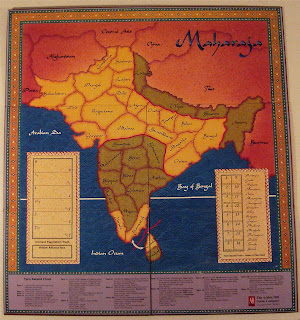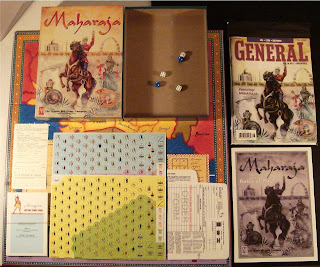HISTORICAL BACKGROUND
Britain’s conquest of India began, as it had with so much of the rest of the British Empire, with the arrival of the first English traders. In 1617, the English East India Company's toehold on the subcontinent expanded when it was formally granted trading rights by the Mogul Empire; once these commercial privileges had been secured, the East India Company wasted no time but quickly set about building shipping centers and depots at strategic locations along the Indian Coast. Of course, once these various enclaves had been established, it was only sensible for the British to build forts to protect their gradually expanding commercial holdings. The next stage, for these early representatives of the British Crown, like the first, was inevitable: once company forts had been established, it followed, as the night follows the day, that it was then essential for the East India Company to raise a private army to garrison these newly-erected forts and to protect its ever-expanding territorial and commercial interests. Moreover, in the eyes of these ambitious English traders, a private army was, not surprisingly, considered to be a very handy thing to have.During the next century, the East India Company steadily increased its land holdings and its local political influence by shrewdly supporting one local tribal leader against another in the numerous internecine wars that plagued India during the fractious period of the Mogul decline. The British, however, were not alone among the European powers in their determination to ultimately take control of the Indian subcontinent; their main competitors — the unpleasant and always quarrelsome French— had also established a foothold in India through the economic and military machinations of the East India Company’s Gallic doppelganger, the Compagnie française des Indes orientales. As time passed, friction between the two European companies only grew, and a major clash between the French and British gradually came to be seen by both as being inevitable. Finally, the increasingly bitter trading rivals resorted to what must have seemed perfectly natural to two commercial adversaries both of which employed their own private armies: they went to war with each other.
In the 1740s and 1750s, a series of military engagements, known collectively as the 'Carnatic Wars' was fought between the soldiers, agents, and allies of the two competing trading companies. In 1757, a British force led by Robert Clive (that’s right: the 'Clive of India') decisively defeated the French and their Indian allies at the Battle of Plassey. This crushing victory over Britain’s only remaining adversary left the English East India Company in undisputed control of Bengal and established it, at long last, as the preeminent political and military power in India. It also meant that Indian self-rule was now doomed.
Clive’s military success had far-reaching effects for both England and for India. The British victory at Plassey not only disposed of the French, it also cleared away the last serious obstacle to English domination of the Indian subcontinent; the establishment of the British Raj was now only a matter of time.
DESCRIPTION
 MAHARAJA is a grand strategic simulation on a truly epic scale. It is a game — like its predecessor and close relative, BRITANNIA — for those players who genuinely take the long view of history. The game covers the dynamic, exciting, and often violent period in India’s history from the early Aryan invasions, beginning around 1500 B.C., to the colonial conquest of the subcontinent by the British in 1850 A.D. MAHARAJA is intended to be a multi-player game: each player is assigned a color prior to the start of play; each player color determines which nations (peoples) a player will control over the course of the entire game. These different nations each appear during specific historical periods (game turns) and compete with the nations of other players for control of geographical regions on the game map. In the course of the game, players will attempt to amass victory points using armies, population markers, and leaders. Victory points can only be gained through the occupation of areas, conquest of opposing nations’ areas, destruction of enemy units, and the acquisition of raj points. The game’s winner is the player with the most points at the end of the last (16th) game turn.
MAHARAJA is a grand strategic simulation on a truly epic scale. It is a game — like its predecessor and close relative, BRITANNIA — for those players who genuinely take the long view of history. The game covers the dynamic, exciting, and often violent period in India’s history from the early Aryan invasions, beginning around 1500 B.C., to the colonial conquest of the subcontinent by the British in 1850 A.D. MAHARAJA is intended to be a multi-player game: each player is assigned a color prior to the start of play; each player color determines which nations (peoples) a player will control over the course of the entire game. These different nations each appear during specific historical periods (game turns) and compete with the nations of other players for control of geographical regions on the game map. In the course of the game, players will attempt to amass victory points using armies, population markers, and leaders. Victory points can only be gained through the occupation of areas, conquest of opposing nations’ areas, destruction of enemy units, and the acquisition of raj points. The game’s winner is the player with the most points at the end of the last (16th) game turn.  MAHARAJA uses a game system that is comparatively simple, yet unpredictable. For starters, the game is played with a variable player turn order: players move their units according to the order outlined on the Nation Control List. A typical game turn proceeds with the following strictly-ordered sequence of player actions: Increase Population Phase; Invasion Phase; Movement Phase; Battle Phase; Factory Phase; Arms Phase; and, at the end of certain game turns, the Victory Point Count Phase. In the course of the game, players will find themselves variously in control of weak and strong nations. Thus, players will accumulate victory points at different rates during different historical epochs. Not to worry though, the ingenious game design balances out these inequalities over the span of the whole game, so that the victory point opportunities of the different players wax and wane as the game progresses and new nations enter play. Another interesting feature of MAHARAJA is that at different stages in the game, players may find themselves controlling several different nations that are in direct competition for the same geographical areas. Thus, in order to gain and keep victory points, a player may occasionally be obliged to attack himself! MAHARAJA offers not only a standard four-player version of the game, but also a five-player, and a standard and shortened three-player version, as well. There are no optional rules.
MAHARAJA uses a game system that is comparatively simple, yet unpredictable. For starters, the game is played with a variable player turn order: players move their units according to the order outlined on the Nation Control List. A typical game turn proceeds with the following strictly-ordered sequence of player actions: Increase Population Phase; Invasion Phase; Movement Phase; Battle Phase; Factory Phase; Arms Phase; and, at the end of certain game turns, the Victory Point Count Phase. In the course of the game, players will find themselves variously in control of weak and strong nations. Thus, players will accumulate victory points at different rates during different historical epochs. Not to worry though, the ingenious game design balances out these inequalities over the span of the whole game, so that the victory point opportunities of the different players wax and wane as the game progresses and new nations enter play. Another interesting feature of MAHARAJA is that at different stages in the game, players may find themselves controlling several different nations that are in direct competition for the same geographical areas. Thus, in order to gain and keep victory points, a player may occasionally be obliged to attack himself! MAHARAJA offers not only a standard four-player version of the game, but also a five-player, and a standard and shortened three-player version, as well. There are no optional rules. A PERSONAL OBSERVATION
 Some players, it goes without saying, like multi-player games that attempt to capture the broad sweep of history, and some don’t. For my own part, the personalities of the other players at the table are at least as important as the game being played. A convivial group of gamers can make even a relative "dog" a pleasure to play. MAHARAJA is far from a dog, and even accepting that some of the game’s history is a little dodgy — the whole Aryan Invasion Theory has recently come under fire, for instance — it nonetheless is an informative and enjoyable game when sitting in with the right company. For that reason, although MAHARAJA is certainly not my favorite multi-player game of this type, I still feel comfortable recommending it. Based on my own experience at the game table, I would say that anyone who likes BRITTANIA will almost certainly like this game. In terms of play, MAHARAJA requires a nice mix of diplomacy, luck, guile, and tactical acumen in order to win. In addition, it also has the unexpected advantage of painlessly teaching the players about an epoch in the Indian subcontinent’s history about which most of us in the West know far too little!
Some players, it goes without saying, like multi-player games that attempt to capture the broad sweep of history, and some don’t. For my own part, the personalities of the other players at the table are at least as important as the game being played. A convivial group of gamers can make even a relative "dog" a pleasure to play. MAHARAJA is far from a dog, and even accepting that some of the game’s history is a little dodgy — the whole Aryan Invasion Theory has recently come under fire, for instance — it nonetheless is an informative and enjoyable game when sitting in with the right company. For that reason, although MAHARAJA is certainly not my favorite multi-player game of this type, I still feel comfortable recommending it. Based on my own experience at the game table, I would say that anyone who likes BRITTANIA will almost certainly like this game. In terms of play, MAHARAJA requires a nice mix of diplomacy, luck, guile, and tactical acumen in order to win. In addition, it also has the unexpected advantage of painlessly teaching the players about an epoch in the Indian subcontinent’s history about which most of us in the West know far too little! Design Characteristics:
- Time Scale: variable (500 to 50 years per game turn)
- Map Scale: not given (area movement)
- Unit Size: not given
- Unit Types: leaders, armies, increase population markers, colonial factories, colonial arms, and information markers
- Number of Players: 3-5
- Complexity: low
- Solitaire Suitability: low
- Average Playing Time: 3-4 hours (depending on which version of the game is being played)
Game Components:
- One 22” x 24” Area Movement Map Board (with Turn Record Track/Order of Play Chart, Turn Record (Historical Events) Chart, Increase Population Track, and British Alliance Box incorporated)
- 264 mixed-sized cardboard Counters
- One 8” x 11” Rules Booklet (with Victory Point Records for Five, Four, and Three-Player Games, and Historical Background Notes incorporated)
- Five six-sided Dice
- Seventeen 4” x 6” Victory Point Cards
- One 4” x 6” Nation Control Chart
- One Avalon Hill Order Form/Mailer
- One Customer Response Card
- One 8½” x 11½” x 2” bookcase-style Game Box









0 comments:
Post a Comment